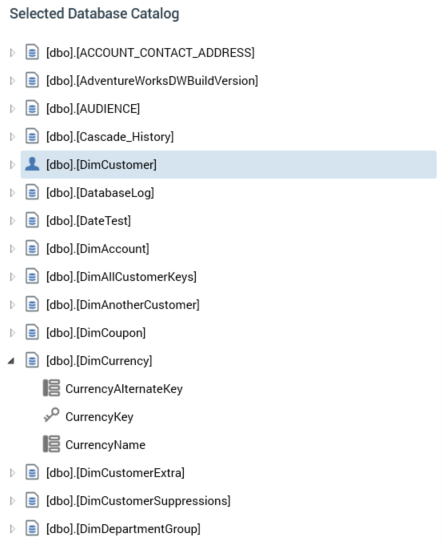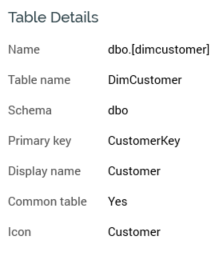Database treeview
Overview
Database tables of which details are held within the catalog are displayed in a treeview, which forms the main section of the Catalog configuration interface. The contents of the treeview reflect the context specified at the Select Database section’s Database property.
If the selected database has yet to be cataloged, a message is displayed instead:

Please see the Synchronize Catalog documentation for further information.
The IsVisible column in the tenant's Interaction_XXX operational database table dm_TableMappings can be used to control whether a table is shown in the catalog; if set to 1, the table is displayed, if set to 0, it is not (note that if this value is changed you will need to refresh the catalog to display or remove the table in question).
Also, system configuration setting CatalogRPITempTables can be used to control whether temporary tables are displayed in the catalog. If set to True, all tables are shown. If set to false, the following tables are not displayed in the Catalog:
Dataflow_*
RPI_OH_*
RPI_*_axml_*

The treeview is read-only. Database tables are ordered first by schema, then by table name, and are displayed as ‘[schema name].[table name]’. You can expand a table to view an alphabetical list of the columns it contains or roll up list of columns to view the table name only.
When you hover over a table…

…or a column…

…an informational tooltip is displayed.
Additional treeview options
You can right-click a table or column in the treeview to display a context menu, exposing two options: Use Column and Primary Key and View usage.
Use Column as Primary Key
This option is only shown when right-clicking a column. When you set a column as a table’s primary key a key icon is displayed next to the column’s name. Setting a table’s primary key can improve the efficiency of SQL query execution when running selection rules and audiences. You can also unset a table’s primary key using Clear Primary Key context menu option.
View usage
This option is available at both tables and columns. It allows you to view usage information relating to the selected database item. Selecting it displays the Table/Column Information dialog, which contains the following:

Title: “Schema.[tablename] (plus .[columnname] if appropriate)”.
Tab set: exposing Details and Usage tabs.
Details tab
This tab displays table or column details, showing the same information as per the Selected Item Details section to the right of the Catalog interface.

Usage tab
This tab is displayed by default. It contains a toolbar and files list.

Toolbar: exposing the following options:
Show: this dropdown allows you to display directly dependent files (for example, a database column attribute that references a column) or all dependent files (for example, a standard selection rule that references the aforementioned attribute).
Previous page: this button is enabled when more than one page of results is shown, and a page other than the first is displayed. Selecting it displays the previous page's results.
Next page: this button is enabled when more than one page of results is shown, and a page other than the last is displayed. Selecting it displays the next page's results.
Export usage list: Selecting this button displays the Save Usage Details Windows file system dialog. At the same, the File name property is set to '<Dialog Title> Usage <yyyy-mm-dd>‘ and Save as type to 'Tab Delimited Files'. When you select Save, a file containing usage details is written to the specified location. An information message confirms the successful export. Selecting Cancel removes the dialog from display. The exported file contains the following:
ID
VCID (version control ID)
Name
Type
Subtype
Created By
Created (dateTime)
Modified By
Modified (dateTime)
Files list: the files list displays files at which the current database item is in use. Configuration collections are shown, if appropriate. Files are presented in alphabetical order by default. The following columns are shown:
File Name: note that the following inline buttons are shown on hover:
Open Latest Version (where appropriate)
Open File Location
File Type
Folder Path
The display of views in the database treeview is supported, as are Snowflake Hybrid tables.
